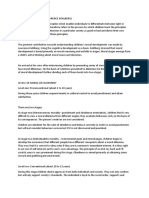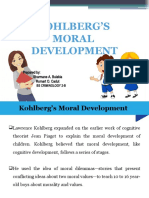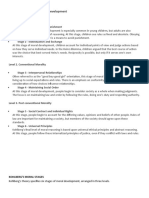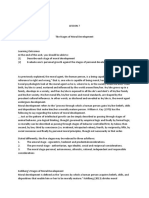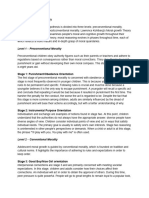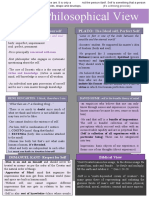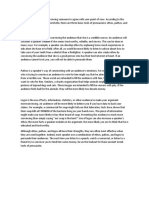Kohlberg's Theory of Moral Development
Kohlberg's Theory of Moral Development
Uploaded by
Navin MehtaCopyright:
Available Formats
Kohlberg's Theory of Moral Development
Kohlberg's Theory of Moral Development
Uploaded by
Navin MehtaOriginal Title
Copyright
Available Formats
Share this document
Did you find this document useful?
Is this content inappropriate?
Copyright:
Available Formats
Kohlberg's Theory of Moral Development
Kohlberg's Theory of Moral Development
Uploaded by
Navin MehtaCopyright:
Available Formats
Kohlberg grouped stages of moral development into three levels, each containing two stages.
LEVEL ONE: PRECONVENTIONAL STAGEs At these first two stages, the Childs able to respond to rule and social expectations and can apply the labels good , bad, right, wrong. Right wrong are interpreted in term of the pleasant or pain full consequences of action or in term of physical power of those who set the rule.
a)
b)
Stage one: Punishment and obedience orientation- At this stage ,the physical consequences of act wholly determine the goodness or badness of an act. The childs reasons for doing the right thing are to avoid punishment or defer to the superior physical power of a authorities. Stage two: instrumental and relative orientation- At this stage, right action become those that can serves as instruments for satisfying the childs own needs or the needs of those for whom the child cares. The child is now aware that others have needs and desires similar to his or her own.
a)
LEVEL TWO: CONVENTIONAL STAGEMaintain the expectations of ones own family, peer group, or nation is now seen as valuable in its own right, regardless of the consequences. If one were to ask an adolescent at this level about why something is wrong or why it is right, adolescent would probably answer in term of what my family has taught me , what my friends think . Stage three : Interpersonal concordance orientation- good behavior at this early conventional stage is living to the expectations of those for whom one feel loyalty, affection and trust. Right action is conformity to what is generally expected in ones role as a good son, daughter, brother, friends and so on.
Doing right is motivated by the need to be seen as a good performer in ones own eyes and in the eyes of others. b) Stage four: Law and order Orientation- Right and wrong at this moral mature conventional stage now come to be determine by loyalty of ones own larger nation or surrounding society. Laws are to be upheld except where they conflict with other fixed social duties. The person is now able to see other people as parts of large social system that defines individual roles and obligations , and he or she can separate the norms generated by this system from interpersonal relationship and motives.
a)
LEVEL THREE: POSTCONVENTIONAL STAGEAt this stages, the person no longer simply accepts the values and norms of the groups to which he or she belong. The person questions the law and values that society has adopted and redefine them in term of self-chosen moral principles that can be justified in rational terms. Stage five: Social contract OrientationAt this first post conventional stage, the person become aware that people hold a variety of conflicting personal views and opinions and emphasizes fair ways of reaching consensus by agreement, contract, and due to process.
b) Stage six: Universal Ethical principles Orientations- At this stage, right action comes to be defined in terms of moral principles chosen because of their logical comprehensiveness , universality, and consistency. The persons reasons for doing what is right are based on a commitment to these moral principles, and the person sees them as the criteria for evaluating all other moral rules and arrangements, including democratic consensus.
Kohlberg found that many people remain stuck at one of the early stages through out their lives. The person at the pre conventional level can see situations only from the persons own egocentric point of view. The person at conventional level can see situations only from the familiar view points of people in the persons own social group. The person at post conventional level has ability to look at situations from a perspective that tries to take into account everyone affected by decision.
You might also like
- Educational Leadership: a Student-Centered ApproachFrom EverandEducational Leadership: a Student-Centered ApproachNo ratings yet
- Exemplary Classroom Questioning: Practices to Promote Thinking and LearningFrom EverandExemplary Classroom Questioning: Practices to Promote Thinking and LearningRating: 5 out of 5 stars5/5 (1)
- Fostering International Student Success in Higher Education, Second Edition: copublished by TESOL and NAFSAFrom EverandFostering International Student Success in Higher Education, Second Edition: copublished by TESOL and NAFSANo ratings yet
- Alternate Assessment of Students with Significant Cognitive Disabilities: A Research ReportFrom EverandAlternate Assessment of Students with Significant Cognitive Disabilities: A Research ReportNo ratings yet
- Effects of an Inclusion Professional Development Model on Inclusion Knowledge and Perceptions of Regular Middle School EducatorsFrom EverandEffects of an Inclusion Professional Development Model on Inclusion Knowledge and Perceptions of Regular Middle School EducatorsNo ratings yet
- Early Childhood Education and Development in Indonesia: An Assessment of Policies Using SABERFrom EverandEarly Childhood Education and Development in Indonesia: An Assessment of Policies Using SABERNo ratings yet
- Well-Child Care in Infancy: Promoting Readiness for LifeFrom EverandWell-Child Care in Infancy: Promoting Readiness for LifeNo ratings yet
- Empowering Students For Success: Family Relationships are the Basis of the Student's SuccessFrom EverandEmpowering Students For Success: Family Relationships are the Basis of the Student's SuccessNo ratings yet
- Enhancing Competency of Teachers: A Teaching-And-Learning Enhancement GuideFrom EverandEnhancing Competency of Teachers: A Teaching-And-Learning Enhancement GuideNo ratings yet
- Moral DevelopmentDocument15 pagesMoral DevelopmentJasleenDianaNo ratings yet
- Lecture 5 Moral DevelopmentDocument26 pagesLecture 5 Moral DevelopmentFatima HumayunNo ratings yet
- Lawrence Kohlberg's Theory of Moral DevelopmentDocument4 pagesLawrence Kohlberg's Theory of Moral DevelopmentkhushaldinaniNo ratings yet
- Ethics Stages of Moral Development HandoutDocument3 pagesEthics Stages of Moral Development Handoutsamandersan472No ratings yet
- Lecture 04Document2 pagesLecture 04dopofe8559No ratings yet
- Kohlberg's Theory of Moral DevelopmentDocument3 pagesKohlberg's Theory of Moral DevelopmentJaryl PachecaNo ratings yet
- Kohlberg's Stages of Moral Development: Level 1: PreconventionalDocument2 pagesKohlberg's Stages of Moral Development: Level 1: PreconventionalRei YoshiharaNo ratings yet
- Stages of Moral DevelopmentDocument2 pagesStages of Moral DevelopmentArunodhayam NatarajanNo ratings yet
- Kohlberg's Stages of Moral DevelopmentDocument3 pagesKohlberg's Stages of Moral DevelopmentFlyff CancerNo ratings yet
- CathDocument3 pagesCathmarkkennethNo ratings yet
- Moral Development TheoryDocument2 pagesMoral Development Theorypatricia shatzNo ratings yet
- Business Ethics Kholberg's Theory ExplainedDocument1 pageBusiness Ethics Kholberg's Theory ExplainedMarium HasanNo ratings yet
- Kohlberg'S Moral Development: Prepared By: Sharmane A. Bulakia Romart O. CadutDocument18 pagesKohlberg'S Moral Development: Prepared By: Sharmane A. Bulakia Romart O. Cadutunknown UnknownNo ratings yet
- 9 The Moral Development Stages of The Moral AgentDocument4 pages9 The Moral Development Stages of The Moral AgentChristine Joy VillasisNo ratings yet
- Topic VIIDocument3 pagesTopic VIIKate AbuyuanNo ratings yet
- Ethics NotesDocument15 pagesEthics NotesBHAVYAN AGARWALNo ratings yet
- Kohlberg Identi-WPS OfficeDocument2 pagesKohlberg Identi-WPS OfficeVince AbearNo ratings yet
- Abby Report EthicsDocument3 pagesAbby Report EthicsAbegail LucapaNo ratings yet
- Level 1 (Pre-Conventional)Document4 pagesLevel 1 (Pre-Conventional)aditya birlaNo ratings yet
- Kohlberg THEORYDocument3 pagesKohlberg THEORYMyk Patrick VillanuevaNo ratings yet
- Stage 1: Obedience-and-Punishment OrientationDocument2 pagesStage 1: Obedience-and-Punishment OrientationAce Fati-igNo ratings yet
- D Kohlberg On Moral DevelopmentDocument7 pagesD Kohlberg On Moral DevelopmentRandyNo ratings yet
- Ethics - LESSON 7 The Stages of Moral DevelopmentDocument7 pagesEthics - LESSON 7 The Stages of Moral DevelopmentRhea LanuzaNo ratings yet
- LAWRENCE KOHLBERG Moral Development TheoryDocument3 pagesLAWRENCE KOHLBERG Moral Development TheoryAbdulHamid GomampongNo ratings yet
- Child Development: Moral Development: Forming A Sense of Rights and ResponsibilitiesDocument9 pagesChild Development: Moral Development: Forming A Sense of Rights and ResponsibilitiesBelle AmariNo ratings yet
- Kohlberg Stages of Moral Development Level 1: Preconventional LevelDocument2 pagesKohlberg Stages of Moral Development Level 1: Preconventional LevelShane Aileen AngelesNo ratings yet
- Moral-Development TheoryDocument2 pagesMoral-Development TheoryHeaven Leigh SorillaNo ratings yet
- Stages of MoralityDocument33 pagesStages of MoralityGintokiNo ratings yet
- Moral Development TheoryDocument3 pagesMoral Development TheorySpoodsNo ratings yet
- (Ethics Assignment)Document2 pages(Ethics Assignment)Out of MindNo ratings yet
- Ethics Chapter 1 Lesson 6 Stage of Moral DevelopmentDocument5 pagesEthics Chapter 1 Lesson 6 Stage of Moral Developmentantoman.jeraldNo ratings yet
- Kohlberg's Stages of Moral Development Theory (Edited)Document11 pagesKohlberg's Stages of Moral Development Theory (Edited)Joshua AlmueteNo ratings yet
- Kurt Lewin and KohlbergDocument4 pagesKurt Lewin and KohlbergSarah Dela RosaNo ratings yet
- Kohlberg's Stages of Moral DevelopmentDocument4 pagesKohlberg's Stages of Moral DevelopmentobaidulNo ratings yet
- Unit 3: Kohlberg'S Stages of Moral DevelopmentDocument5 pagesUnit 3: Kohlberg'S Stages of Moral Developmentted deangNo ratings yet
- DocumentDocument4 pagesDocumentAbigail Awortwe AndohNo ratings yet
- Moral Development and Moral ReasoningDocument2 pagesMoral Development and Moral ReasoningNaga LipikaNo ratings yet
- KohlbergDocument3 pagesKohlbergReah LaurelNo ratings yet
- 1st Communication For Various PurposesDocument2 pages1st Communication For Various PurposesAngela Mae EsquivelNo ratings yet
- Communication in Cognitive Behavioral Therapy PDFDocument286 pagesCommunication in Cognitive Behavioral Therapy PDFbhasi100% (1)
- Portfolio - Awr3Document8 pagesPortfolio - Awr3MARIANo ratings yet
- Heineken BeerDocument9 pagesHeineken BeerBalajisiom100% (1)
- Business Communication 2021Document2 pagesBusiness Communication 2021Haryana AaleNo ratings yet
- Speech Prepare in 15 MinutesDocument114 pagesSpeech Prepare in 15 MinutesjohnsmooreNo ratings yet
- Thesis 2021 2Document84 pagesThesis 2021 2Julie SisonNo ratings yet
- Michael BreenDocument4 pagesMichael Breenlancelot85100% (1)
- FOME Team, Teamwork & LeadershipDocument30 pagesFOME Team, Teamwork & LeadershipNixy ClaudiaNo ratings yet
- Oral Comm Module 8Document5 pagesOral Comm Module 8Elmerito MelindoNo ratings yet
- The Challenges of Middle and Late Adolescence: Lesson ContentDocument4 pagesThe Challenges of Middle and Late Adolescence: Lesson ContentErron Francisco Nicol100% (1)
- Gts PosterDocument1 pageGts Posterapi-333550548No ratings yet
- Factors Influencing The Course Preference and Academic Performance of FreshmenDocument53 pagesFactors Influencing The Course Preference and Academic Performance of FreshmenZipporah de la CruzNo ratings yet
- Understanding The Self NotesDocument4 pagesUnderstanding The Self NotesINTALAN, FRITZ L.No ratings yet
- Perdev Various RoleDocument15 pagesPerdev Various Roler.yzabelNo ratings yet
- Provision of Technical Assistance Mathematics Department First QuarterDocument9 pagesProvision of Technical Assistance Mathematics Department First QuarterXyr FloresNo ratings yet
- Models of CommunicationDocument22 pagesModels of CommunicationHannah Faith TablatinNo ratings yet
- Professional Education MDocument10 pagesProfessional Education MRoyana Joy Fuentes100% (1)
- Emotion Vs MoodsDocument9 pagesEmotion Vs Moodsmd. romganNo ratings yet
- PR1-Characteristics and KindsDocument28 pagesPR1-Characteristics and KindsNicole VaronaNo ratings yet
- Toxic RelationshipDocument12 pagesToxic Relationship202132033No ratings yet
- Psychoedu-Intro W1Document18 pagesPsychoedu-Intro W1ABDUL AZIM DANIEL AB RAHIMNo ratings yet
- SampleDocument2 pagesSampleAnna Marie DayanghirangNo ratings yet
- CommunicationDocument18 pagesCommunicationD. J. Anderson B.No ratings yet
- 303Document2 pages303HeidiNo ratings yet
- Persuasion Is The Art of Convincing Someone To Agree With Your Point of ViewDocument1 pagePersuasion Is The Art of Convincing Someone To Agree With Your Point of ViewEmanuel Doria0% (1)
- Gardner's Multiple Intelligences: Tracy Green Lindsay Shrader Kathleen Hurst Wendy GortonDocument11 pagesGardner's Multiple Intelligences: Tracy Green Lindsay Shrader Kathleen Hurst Wendy GortonReggie Boy BeringuelaNo ratings yet
- Psychological Testing-II Report Submitted by Fatima Syed Fa17-Bpy-016Document53 pagesPsychological Testing-II Report Submitted by Fatima Syed Fa17-Bpy-016Fatima SyedNo ratings yet
- Perspective On Teaching and LearningDocument67 pagesPerspective On Teaching and LearningJoybelle HarayoNo ratings yet
- Bioethics: By: Dr. Fe M. CompasDocument15 pagesBioethics: By: Dr. Fe M. CompasReymart BolagaoNo ratings yet
































